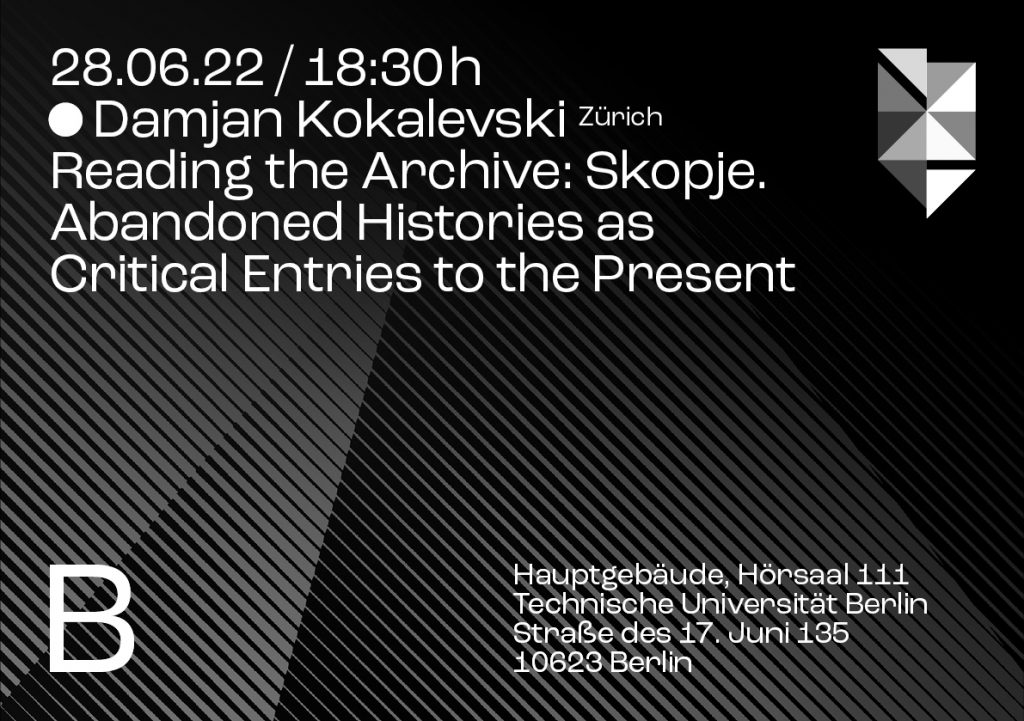Damjan Kokalevski (Munich/Skopje): Reading the Archive: Skopje. Abandoned Histories as Critical Entries to the Present
Skopje has been in the recent media spotlight as an example of how a city transformed to legitimize and reinforce populist and nationalist power structures. In 2009 the former right-wing ruling party launched a grand project for a violent rebuilding of the city center, designed in a pseudo-neoclassical style, titled “Skopje 2014”. It aimed to connect the Macedonian people to their mythical roots, dating back to Alexander the Great, trying, at the same time, to make the city look more ‘European’. Since then, numerous new buildings and monuments have sprung up in an opaque and corrupt commission process, costing approximately 680 million euros. In parallel to this, the architectural heritage and expertise gained after the disastrous earthquake of 1963, thanks to an extensive reconstruction project led by the United Nations, is obscured, abandoned, or even destroyed.
This lecture focuses on the archival remains of the Institute for Town Planning and Architecture Skopje. The Institute and its archive had been abandoned and foreclosed in recent years and were finally destroyed in a fire in 2017. Most of the valuable materials from the rebuilding of Skopje—original drawings, plans, models, photographs, records, and proceedings—disappeared in the fire. The Institute became internationally established with the help of the U.N. and took the task of planning the new city after the earthquake. They commissioned more than 200 experts from both sides of the Iron Curtain to design the new city with great urgency. Among others, famous architects like Constantinos Doxiadis, Kenzo Tange and Van der Broek and Bakema prepared plans for the new town. Heavily influenced by the Cold War narrative of the impending nuclear war, Skopje became a hallmark of international cooperation and was proclaimed ‘The City of Solidarity’. The U.N. utilized architecture and urban planning as essential tools for navigating progress and international development and presented the example of Skopje both as a propaganda machine and a solution to the problems ‘of the troubled world’. Since the 1990s, after the violent breakup of socialist Yugoslavia, the Institute has been a victim of rampant privatization and selling out of state-owned amenities from which it never recovered.
The proposal to “read the archive” places this research in the middle of that historical context. Framed as a performative practice, it claims that we need to reinterpret and reassemble the archive of Skopje by exploring various working methods and activities, including exhibiting, discussing, teaching, writing, and building. Who would be interested in this archive, and could it become a popular source of architectural knowledge? Would it operate solely in the academic sphere or extend to a broader cultural context? If we look at the status of the Skopje archive, could we recognize global trends, such as the recent rise of nationalism and populism throughout Europe, as symptoms that appear in a broader socio-political context and, above all, find ways to intervene in the ways that knowledge production and power are entangled? Ultimately, such recognition would reposition Skopje’s history, allowing it to move away from the peripheries of history and become a critical entry point to the current spatial and political issues.
Damjan Kokalevski is postdoctoral associate at the Architekturmuseum der TUM in Munich, leading the Digital Archive. His doctoral dissertation “Performing the Archive: Skopje. From the Ruins of the City of the Future,” completed at the Swiss Federal Institute of Technology in Zurich in 2018, investigates the neglect of the architectural knowledge gained during the rebuilding of Skopje following the 1963 earthquake, focusing on the United Nations’ involvement in the process. He contributed to the exhibition “Metabolism: The City of the Future” at the Mori Art Museum, Tokyo (2012), curated the exhibition “Performative Archive: Skopje, Discussing Urban Reconstruction” with gta Exhibitions Zurich (2014), and co-curated “Living With Water: Southern Fringe of Ljubljana” at the Museum of Architecture and Design, MAO Ljubljana (2018), and “Unfolding Cities. The Photobook as Archive” at AFF Gallery Berlin (2021). He is the author of the book “Skopje Walkie Talkie” together with Susanne Hefti, published by Spector Books in 2019, the editorial assistant of “The Industrious City. Urban Industry in the Digital Age”, together with Hosoya Schaefer Architects Zurich, published by Lars Müller Publishers in 2021, and the co-editor of the “Future Architecture Book” published by MAO Ljubljana 2021. Working as an architect, curator, writer, and activist led him to co-found City Creative Network, a citizen initiative and an urban research center in Skopje. In 2015 together with a group of students, they realized the project “Nautilus Construct: Building an Open Stage for Skopje” as a reaction to the recent nationalistic remaking of the city center. As a frequent collaborator on architectural projects, he most recently co-designed “Komitet”, an LGBTQI+ community center in Skopje, as a donation, and the urban concept for “Prespa Forum for Political Dialogue” located at the shores of Prespa Lake near the North Macedonia-Greece border. His recent thematic interest lies in a critical recontextualizing of architectural and technological histories by examining their digital futures and devising intersectional frameworks for ‘making things visible’.
Universitätsbibliothek der TU und UDK Berlin
Fasanenstraße 88
Raum Bib 014
